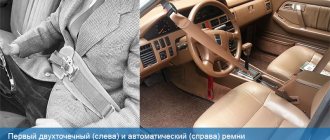What are airbags?
Airbags are elastic fabrics or other materials that are tightly packed in different areas of your vehicle. Most cars have airbags on the front dashboard, and many cars have airbags along the side of the car. These bags are compressed and stored in a small area. When an accident occurs , they provide a cushioning system for the people in the car to help prevent them from being thrown out in the event of an accident. While it won't always save you from serious injury or death, there are many situations where occupant cushioning can make a lot of sense.
The first Airbag design was patented in 1951, but the auto industry was slow to adopt the technology until the 70s.
How to find airbags in a car?
Airbags in a car are indicated by airbag icons . These badges can either be embossed onto plastic or applied to special fabric tags.
We have already discussed above where each type of pillow is located. Front, knee, rear side and curtain airbags are usually marked on plastic trim pieces; front side airbags are marked on fabric tags on the side of the seats.
I do not recommend opening or disassembling the interior trim near the airbags without disconnecting the battery. Trying to remove the airbag while it is under tension may cause it to deploy. This, in turn, can lead to serious injuries.
How do they work?
- Each individual airbag is inflated and packaged in a compartment located in the dashboard, steering wheel, seat or other location.
- The front Airbag includes a large nylon bag that inflates and deflates quickly in the event of a serious frontal collision.
- Airbag deployment is monitored by sensors that detect the occurrence and severity of an accident. When the controller determines that the Airbag needs to be deployed, the system starts the inflator unit, which in turn burns chemicals that produce a lot of inert gas to inflate the bag.
- When the bag inflates, it rips open the covers on the dashboard, floating in front of the passenger. At the same time, the head and upper part of the passenger move with considerable force towards the inflated bag. When the occupant's head comes into contact with the airbag, it begins to deflate through the vents in the base. This softens the forward movement of the head. The entire process happens in the blink of an eye, in about 100 milliseconds.
- There will be a lot of smoke, dust and noise during deployment, and the passenger may not be aware that the airbag has deployed. This is fine.
Design and principle of operation of airbags
The secret of instantly filling airbags with air actually lies not so much in the airbags themselves, but in a special device - a gas generator. This is the most technically complex part in the entire Airbag system. The gas generators used in airbags can inflate an airbag about three times faster than you can blink. At the end of the article, watch a video about how an airbag works and what production stages it has to go through before being installed on a car.
The operating principle of airbags is quite simple. They are triggered upon impact when the vehicle speed exceeds 20 km/h.
- If the car collides with an obstacle, one or more special sensors are triggered. These sensors can be installed on the front, rear and sides of the vehicle.
- Signals from the sensors are processed by the electronic control unit (ECU), which controls the operation of the Airbag system. Under certain conditions (for example, a strong frontal or oblique impact, hitting a high curb, a hard fall after a jump, etc.), the ECU commands the airbags to deploy.
- Based on the programmed algorithm, the control unit decides whether the airbags need to be deployed and transmits an electrical signal for execution.
- This signal enters the airbag gas generator, and a pyrotechnic charge is triggered in it (the squib fires).
- As a result of the activation of the squib, the sodium acid contained in the gas generator burns, releasing a significant amount of gas (nitrogen), which enters the Airbag and instantly opens it.
Airbags are made of nylon fabric similar to parachute fabric. It has holes through which gas, after inflating the pillow, leaves it in just 0.3 seconds. Rapid deflation is necessary because as air leaves the airbag, it becomes softer.
Each airbag has an inflator attached to it during manufacturing and is then rolled into a compact package (small enough to fit in the steering wheel or passenger side dash). In this case, the gas generator for the driver's airbag is additionally placed in a rubber ring, in which it acts as a balancing weight.
Collision sensors
The most important parts of a successful airbag system are the crash sensors. These small pieces of electronics are designed to let you know when your car is damaged in an accident. They respond to several different sets of stimuli, including sudden stopping and increased pressure (when pieces of the car move due to the force of the collision), etc.
The airbag sensors, located at the front of the cabin, are controlled by various types of sensors that measure:
- wheel speed
- passenger's condition
- brake pressure and impact
- and other car status indicators
The sensors transmit signals to the airbag control unit, which analyzes the data and can control safety functions such as:
- seat belt lock
- automatic door locks
- airbag deployment.
There are two types of sensors used in a car - electrical and mechanical.
Some use an electromechanical "ball and tube" mechanism, which basically consists of a small tube containing a circuit breaker and a ball held together by a small magnet. When the collision occurs, the ball is ejected from the magnet and rolls forward in the tube, pressing a switch that completes an electrical circuit.
Other electrical designs are similar in principle, using a metal roller or spring-loaded weights instead of a ball, or in newer cars an accelerometer to disable the sensor.
Mechanical sensors operate independently of the electrical system and respond similarly to electrical sensors, with a design that actuates a firing pin that triggers a small explosion after an accident.
Because a mechanical sensor does not require a power source, it cannot be disabled like an electrical sensor when the battery is disconnected.
The success of an airbag system depends on the crash sensors working not only accurately but also very quickly, which is why they are the most expensive and technologically advanced part of the airbag system.
Types of pillows and features of their work
Frontal
For those sitting behind the wheel, they are installed inside the steering wheel, for those sitting next to them - in the front panel. The passenger airbag can be switched off at will. The operating principle usually includes two or more stages.
Lateral
The purpose of the side airbags is to protect the knees, pelvis, chest and abdomen of those sitting in the cabin. According to statistics, it is the side blow that turns out to be the most painful and often fatal, because it is impossible to predict it one hundred percent. Typically, these pillows are placed on the backs of the front seats, less often the back seats. If you have a choice, it is better to install two-chamber airbags - in the event of an accident, they will protect the body of the person sitting above and below at the same time.
Curtains
In an accident, the head of the person sitting, no matter whether in front or behind, often suffers from the impact on the door glass. Curtain pillows are needed just to prevent this from happening.
Curtain cushions may vary on different car models. Most often they are installed in the front part of the roof, also between the pillars and at the rear.
Knees
In case of accidents, one of the most vulnerable places for the driver and front passenger is the knees. Knee airbags are needed precisely to protect this part of the body. They are placed under the steering wheel for the driver and under the glove compartment for the person sitting next to him.
Other
The number of all air cushions is not limited to the above set. A central one is also installed in the salons - it opens from the armrests and the front part of the backrest to protect the occupants from a secondary impact. A special pillow was designed even for a pedestrian - after all, in the event of a collision there is a high risk of death. It is placed between the hood and the windshield.
Of course, it will not save the driver from responsibility for the person who was hit, but a safe and relatively unharmed pedestrian is still better than a dead one.
When do airbags deploy?
For the driver or passenger airbag to deploy, the following minimum requirements must be met:
- The car must travel at a speed of more than 25 km/h.
- The impact angle is approximately thirty degrees on either side of the vehicle's centerline (about 60 degrees total).
- The deceleration force is at least equal to that which occurs when a car collides with a stationary barrier at a speed of about 25 km/h.
Note: Front airbags will not deploy in a side, rear or rollover collision as they do not provide additional protection.
Front side airbags
Side airbags are less common than front airbags. They are installed on more expensive cars or in more advanced trim levels.
Front side airbags are designed to protect the shoulder, side and pelvis during a side impact collision. They are usually installed on the side of the front seats (from the side of the car doors).
Vehicles with side airbags must comply with additional cargo regulations. Do not place strongly protruding objects in door pockets. In the event of an accident, they can interfere with the operation of the airbag and harm the person.
Note. In 2021, front side airbags are installed on both domestic (Lada Vesta) and inexpensive foreign models (Renault Logan, Datsun On-do).
Other types of airbags
Dual-stage airbags are a smarter generation of airbags that optimize the level of airbag deployment according to the severity of the crash.
Side and curtain airbags help protect occupants from head, neck and chest injuries during side impacts and rollovers.
Knee pads protect the lower extremities from injuries caused by impacts with the instrument panel.
How to check airbags
If you are purchasing a used car, you should not only make sure that it is in good working order, but also test the operation of the airbags. How to check airbags when buying a car second-hand?
First of all, you should make sure that they should be in this car. Therefore, the first thing you need to do is find the SRS or Airbag designations located on the steering wheel or front panel. There should be no scratches or cracks near the inscriptions, because this indicates that the pillows have already been used. And it is unlikely that the former owner of the car would spend money on charging the airbags in the car. Even if the airbags were filled with gas, no one can guarantee that it was done correctly.
The next step is to find the date when the seat belts were made. The date must be the same for all products. Otherwise, if the data differs, it means that the belts were replaced, for example, after an accident in which the airbags deployed.
How to check the presence of an airbag in a car and its serviceability? There are several more methods:
- Turn the ignition key and look at the dashboard. The “airbag” icon will appear for a couple of seconds and then go out.
- There may be a port located under the steering wheel of the car through which the vehicle's health can be checked. We start the car, wait half a minute, close contacts 4 and 13 using a simple paper clip. This will cause the buttons on the dashboard to blink. You will see an image of a man with a pillow, and this button will blink more often than others. This means there is a malfunction in the security system.
Is the indicator not blinking at all? This indicates that this function was disabled by the former owner of the car.
The service life of an airbag in a car is 10–14 years. It all depends on the year of production of the car, make and model. After the specified time has elapsed, the cartridge discharges and the airbag stops working. Carefully examine the car glass, including the windshield. Is it obvious that they have been replaced? This means the pillows were most likely used.
Emerging problems
Front airbags are designed to protect people from adults. Since children are smaller, they are at risk of injury from its operation. Therefore, they should not occupy the front seat if the car has an Airbag for the passenger.
The car should not have accessories installed that could limit the deployment of the Airbag or become a missile when it is deployed.
Airbag systems usually have a warning light with an indicator. If the lamp does not go out immediately after starting or comes on while driving, check the owner's manual and have it checked by a workshop. The system has detected an error.
If you don't do this, the airbags may unexpectedly deploy during repairs, especially during electrical work. This can cause serious injury, so leave repairs to qualified personnel.
The airbags deploy with explosive force and are far from the big fluffy airbags some people might imagine. It is not uncommon for minor injuries and abrasions to remain from contact with the pillow.
Several vehicle manufacturers determine the lifespan of airbag components. Usually the airbag warning light comes on and components must be replaced before it goes off.
Airbag gas generator device
Since drivers and passengers come in different sizes, engineers at one time wanted to come up with an Airbag generator that could regulate the amount of gas. Early airbags could not vary their inflation rate relative to the size and position of the person, or the force of the vehicle's collision.
Therefore, the designers came up with a “smart” generator - it has two squibs instead of one. One of them releases gas at only 80 percent (this is enough for a “soft landing”). But if that's not enough, a second squib triggers a secondary fill and the remaining gas fills the Airbag and makes it stiffer.
A typical driver airbag inflator consists of the following main parts (see picture above):
- Housing with combustion chambers;
- Charges No. 1 and No. 2 from sodium acid tablets;
- Auxiliary charge for igniting charge No. 1;
- Two pyrotechnic cartridges for igniting charges;
- Metal filter.
So what happens in the gas generator when the Airbag is activated?
- The squibs installed in the airbag inflator contain a material similar to gunpowder. When they receive a signal from the electronic control unit, they are triggered, generating heat and high pressure.
- When a pyrotechnic cartridge is triggered, the special sodium acid tablets (charge) located there light up in the gas generator housing. These tablets, when burned, release hot but harmless nitrogen-based gas, which deforms the generator housing and leaves it, filling the Airbag.
- Before entering the airbag, the nitrogen passes through a special metal filter, which removes solid particles formed during the combustion of the charge and cools the gas.
- When electricity is supplied to squib #2, it ignites the second charge. The gas generated by the combustion of the charge lifts the stage 2 chamber cap and fills the airbag through the first stage combustion chamber.
From the moment the car gets into an accident until the airbag is completely inflated, no more than 30 milliseconds pass.
Switching off the airbags
Airbags are designed so that they do not need to be turned on, but can sometimes be turned off. This is due to safety reasons as there are cases where they can cause more harm than good.
When a vehicle includes the ability to deactivate the passenger airbags, the deactivation mechanism is usually located on the passenger side of the dashboard.
The procedure for removing the driver's side Airbag is usually more complicated, and if done incorrectly, it can cause the airbag to deploy. If you are concerned that the driver's side airbag may harm you, you should contact a professional to disable it.
Did you like the article? Share on social media networks:
The new cross-country JAC Sihao X8 can replace the Volkswagen Tiguan: video review of the Chinese model
Jac
John Hetrick decided to create his own device after he was involved in a car accident. At that moment his whole family was in the cabin, but fortunately no one was hurt. But this incident made a great impression on the American engineer. The next day he began work on the device and created the first drawings. Since then, the airbags have been upgraded several times. Their mass production began in the 70s of the last century. For the first time they began to be installed on Ford cars.
Read us:
Airbag sensor operation
To operate the airbag, the control unit input receives signals from the impact sensor and the presence of a passenger.
Shock sensor
The impact sensor serves to detect a collision and send a signal to the control unit. It varies in design. For example, there is an electromechanical sensor that closes contacts when a certain setpoint is reached. A current flows through the closed contacts, which triggers a kind of igniter, a chemical reaction occurs, resulting in the release of gas that fills the airbag. A weak blow will not be enough to start the process. If the power supply from the battery is interrupted, and this is quite possible in the event of an accident, the airbags will still be inflated due to the existing capacitor, which has accumulated an electrical charge.
The impact sensor can be located either inside the security system control unit or inside the passenger compartment. In some cases, it is located in the engine compartment and may not be alone.
It is a useful element, but when problems arise with it, you have to fix them yourself or contact specialists. As you get into your car one morning, you discover that the red airbag light has come on. This may be due to the following reasons:
- the shock sensor is faulty;
- poor contact in the connector;
- broken wires;
- one of the instrument panel warning lights is faulty;
- replacing the fuse with the ignition on;
- instrument panel malfunction.
The shock sensor rarely fails on its own. Usually, other reasons influence the indicator's lighting.
If there is high humidity in the places where the security unit connector is located, the contacts may simply oxidize. This means that the crash sensor or airbag is producing an incorrect signal due to changes in circuit resistance. This has a particularly strong effect on operation if a voltage signal arrives at the control unit. That is, the voltage drop it measures will be incorrect. In addition to humidity, a broken wire may be the cause of the fault indication. This happens when soundproofing is applied or other repair work is carried out in places where wires are laid.
If, when the ignition is turned on, the instrument panel goes out, and after that the indicator is constantly on, then the reason is precisely this operation of the panel.
You can reset an error that appears on your own if you connect to the electronic unit using a special adapter and a scanner program. If desired, it would be a good idea to find the shock sensor itself and at least visually verify its integrity. In this case, it is useful to periodically inspect, if possible, all contacts and connections accessible to the eye, as well as monitor the shock sensor for the integrity and condition of its connectors. But it should be borne in mind that disconnecting the circuits while the ignition is on will lead to an error. Therefore, you should not remove the fuse and clean the connectors at this moment.
You can purchase the necessary adapter and install the corresponding scanner program yourself. With its help you can check the shock sensor and the security system as a whole.
Another option for the development of events may be to simply ignore the malfunction. In this case, the airbag may not deploy at the right time. This is possible even if the shock sensor itself is working.
Passenger presence sensor
The speed at which the airbag inflates depends on the weight of the person sitting in the seat. Regulating the speed at the moment of impact is necessary in order to create a layer of gas between the passenger and the panel in the event of a frontal collision, and between the door and the glass in a side collision. Thus, the system calculates the impact force of a person of a certain mass, taking into account the elasticity of the pillow.
The occupancy sensor sometimes creates problems. This happens when its sensitivity decreases. A child in a seat will not be noticed by him, therefore, the airbag may not deploy. In some KIA RIO car models produced between 2006 and 2008, the passenger sensor had significant deficiencies that made themselves felt after some time. Here, on the contrary, the pillow inflated too quickly, which, in turn, could seriously injure the child, whose weight could not be detected by the sensor.
Violation of the integrity of the PB
Car owners should be aware of how to test the airbag crash sensor. After all, the safety of their lives depends on its serviceability.
In most cases, the system itself “tells” the car owner that something is wrong with it. The Airbag or SRS indicator lights up on the dashboard. The most common cause of this problem is a violation of the integrity of the PB.
Because of this, the control device no longer receives impulses from shock sensors, other controllers, seat belts and other system components. In some cars, the seat belts themselves are equipped with sensors that can detect whether they are fastened or not. Therefore, if the driver or passenger forgets to buckle up, the indicator will also light up, signaling a problem with the system.
The fact is that the operation of the safety belt is relevant in the case when the people in the car are buckled up. Otherwise, if the driver does not fasten his seat belts and gets into a road accident, the PBs will fly out at a speed of 200 km/h. And this is already traumatic for a person. A collision with pillows in this case can be compared to hitting a concrete barrier at a speed of 25 km/h!








